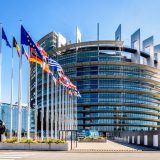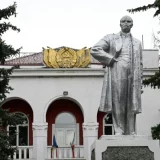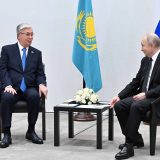The Eastern Europe geopolitical Watch Team : Olga Chekhurska, Khava Doudoucheva, supervised by Clelia Frouté
02/07-08/2022: French President Emmanuel Macron’s mediation tour to Moscow, Kiev and Berlin. -Olga Chekhurska-
On February 7, Russian and French Presidents Vladimir Putin and Emmanuel Macron met in Moscow. The leaders discussed for just over 5 hours mainly about the Ukrainian crisis and Russian-Western tensions.
A number of ideas and proposals by French President Emmanuel Macron “are possible to lay the foundations for common progress“, the Russian president said during a joint press conference. However, according to Putin, the United States and NATO have ignored key points of Russian proposals for security guarantees. Nevertheless, the dialogue continues: the Russian Federation will prepare and send its response to the documents received from Washington and Brussels. The Russian leader stressed that in case of military conflict between Moscow and NATO, there will be no winners and that Moscow does not want such a development of events and will try to find compromises that will suit all. As for Ukraine, the Russian President called on Kyiv to begin to implement the Minsk agreements in relation to which “there is no alternative” [according to him] to settle the situation in the east of the country.
For his part, Emmanuel Macron said that thanks to bilateral dialogue, they can find ways “for a peaceful path and stability in Europe”. He stressed, while opposing “Russia and the West”, that Russia has a “strong position” which does not coincide with the European position on NATO and Ukraine issues. According to Macron, we must take this into account and work to avoid any escalation, but without limiting fundamental European rights and the principles of the agreements of the last thirty years. “We need to find new mechanisms that would ensure stability. We have tried to find points where our positions converge. This should be confirmed in the coming days. It depends on the consultations with the United States, NATO, the Europeans, and our meeting with President Zelensky. The next few days will be decisive,” Macron said.
On February 8, the French leader went to Kyiv, where he met his counterpart Volodymyr Zelensky. At a press conference, Macron said that Ukraine and Russia had confirmed their intention to act in accordance with the Minsk agreements. “Today I heard that from Mr. Zelensky, yesterday from Mr. Putin.” Emmanuel Macron clarified that “the shared determination [to implement the Minsk agreements] is the only way to build peace“. The result of the meeting between Emmanuel Macron and Volodymyr Zelensky was also the signing of several contracts, between Ukroboronprom and Thales, the supply to Ukraine of 130 Alstom locomotives and fire and rescue equipment. France has also lent 1.2 billion euros to Ukraine.
The same evening, the meeting took place in Berlin with the German Chancellor, Olaf Scholz, and the Polish President, Andrzej Duda, still with the aim of avoiding an escalation in Europe. The Heads of State and Government of the Weimar Triangle (Germany, France, and Poland) underlined their commitment to joint efforts to strengthen the European and transatlantic security architecture. At the same time, Olaf Scholz, Emmanuel Macron and Andrzej Duda stressed that “any new Russian military aggression against Ukraine will have serious consequences and a high price“. The Chancellor and the Presidents agreed that NATO should “continuously review its defence and deterrence strategy”. The three leaders declared their support for the territorial integrity and sovereignty of Ukraine. They called for diplomatic efforts and supported the Normandy format and the implementation of the Minsk agreements.
02/11/2022: The National Security and Defence Council of Ukraine imposed sanctions on the Ukrainian TV channel NASH – Olga Chekhurska –
At a National Security and Defence Council meeting in Kharkiv on February 11, sanctions were imposed on the NASH TV channel, which meant the closure of the latter.
Rumours that sanctions might be imposed on NASH TV channel intensified earlier this year. One of the reasons is the announcement by the British Foreign Office on January 22, 2022, that Moscow will look to install a pro-Russian administration in Kyiv after the Russian attack. According to London, this administration should be led by the founder of TV channel NASH, the former MP Yevgeny Murayev. The British Foreign Office claims that Russian intelligence maintains “links with numerous former Ukrainian politicians” and “some of these are involved in the planning for an attack on Ukraine.”
Several far-right groups attacks were last organised, seeking to shut down the TV channel, accusing it of airing pro-Russian propaganda. The latest, after the London accusation, was staged outside the TV station’s offices on February 1, 2022.
Alexey Danilov, the secretary of the National Security and Defence Council, during a briefing, imposed sanctions on the companies that own the channel: NASH 24,
NASH 365 and NASHA Praha. This means that the channel should stop broadcasting. This is not the first time that Ukrainian television channels have been shut down. In 2021, the National Security and Defence Council imposed sanctions against Taras Kozak, the owner of ZIK, 112 and Newsone TV stations. Taras Kozak is also a member of the opposition party “Opposition Platform – For Life” and a close ally of an oligarch considered as pro-Russian Viktor Medvedchuk.
02/10-12/2022: Against the backdrop of the Ukrainian crisis, the Union states of Russia and Belarus are engaged in strategic manoeuvres. – Khava Doudoucheva –
On February 10, Russia and Belarus launched the joint military exercises of the second phase of the “Allied Resolve 2022“, conducted on the southern side and western borders of Belarus, thus close to the borders of Ukraine and the European Union.
As a reminder, the military operations of the “Allied Resolve 2022” took place in two phases. In the first phase, which lasted until February 9, troops and huge quantities of military equipment were transported to Belarus, especially from the Far East. This is highly unusual for a military exercise, analysts say. NATO reported that Russia had deployed Iskander tactical missiles in the Belarusian Republic, among other materials. The Russian defence ministry said it had sent S-400 surface-to-air missile systems and Su-35 fighter planes. They claimed that these systems were only intended to test the air defence capacities of the area.
Then in the same phase, the inspection of the response forces of the Union States was set up, consisting of deploying the equipment and positioning the troops within the territory of the Republic of Belarus. According to the governments of the two Union states, this will be done solely for the purpose of organising the protection and defence of the common border between Ukraine and Belarus.
The second phase began on February 10, with the joint manoeuvres “Allied Resolve 2022“. Russian Defence Minister Sergei Choïgou said that during the exercises, “tasks aimed at ensuring the military security of the State of the Union and the fight against terrorism will be developed“.
The deployment of these soldiers was immediately denounced by the Ukrainian presidency as a means of “psychological pressure” from Russia, which is said to have stationed 30,000 troops in Belarus this month as part of the joint exercises, and more than 100,000 troops near its own border with Ukraine since November. Alexander Lukashenko responded to this by assuring that a war would not be held “unless there is a provocation by crazy Nazis in Ukraine“. At the same time, he said that the presence of these troops and weapons in their current positions could be used against Ukraine “if necessary“.
Sergey Lavrov, head of Russian diplomacy, considered “incomprehensible” the concern of the West about the joint manoeuvres. Russia has also announced the arrival of six warships in Crimea for upcoming manoeuvres in the Black Sea, at the heart of tensions between Moscow and Kyiv. Russia and Ukraine are co-signatories of the 1936 Montreux Convention, which regulates traffic to and through the Black Sea via the Dardanelles and Bosporus straits in peacetime and wartime, and limits the use of the straits by non-riparian states. In particular, the Convention provided a legal basis for limiting the presence of NATO ships in the Black Sea, as military vessels from non-riparian countries could only sail in these waters for a maximum of 21 days. This convention has positioned Turkey and France (France is the depositary of the Montreux Convention) as mediators of tensions between NATO and the Union states as a result.
On Saturday, February 12, telephone conversations were also held between Vladimir Putin and Alexander Lukashenko. The two Union states presidents discussed the reactions of the United States and NATO to Russian proposals on security guarantees and compromises to be negotiated in the Ukrainian crisis, the Kremlin said. The Belarusian leader’s press service confirmed these statements.






